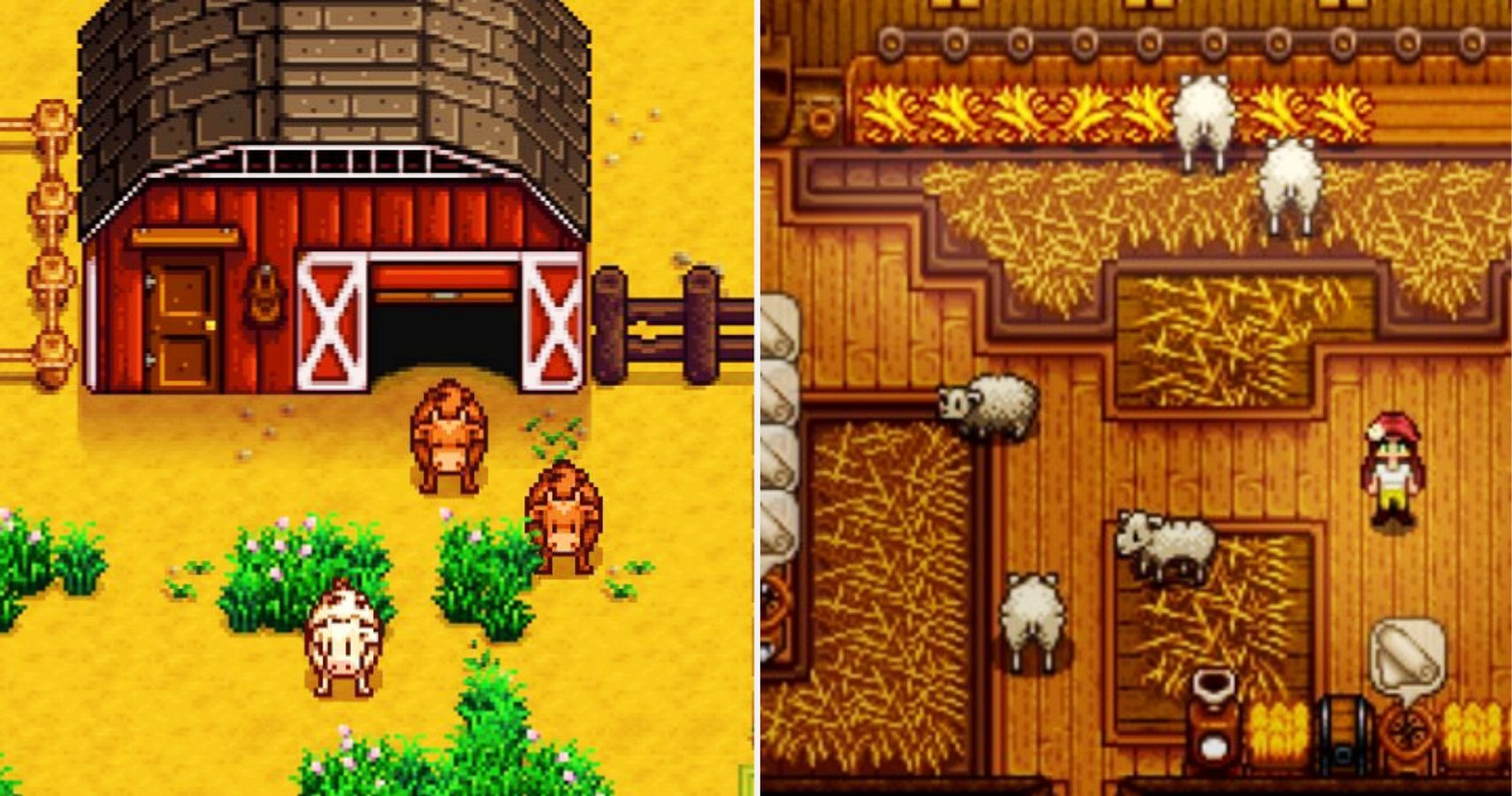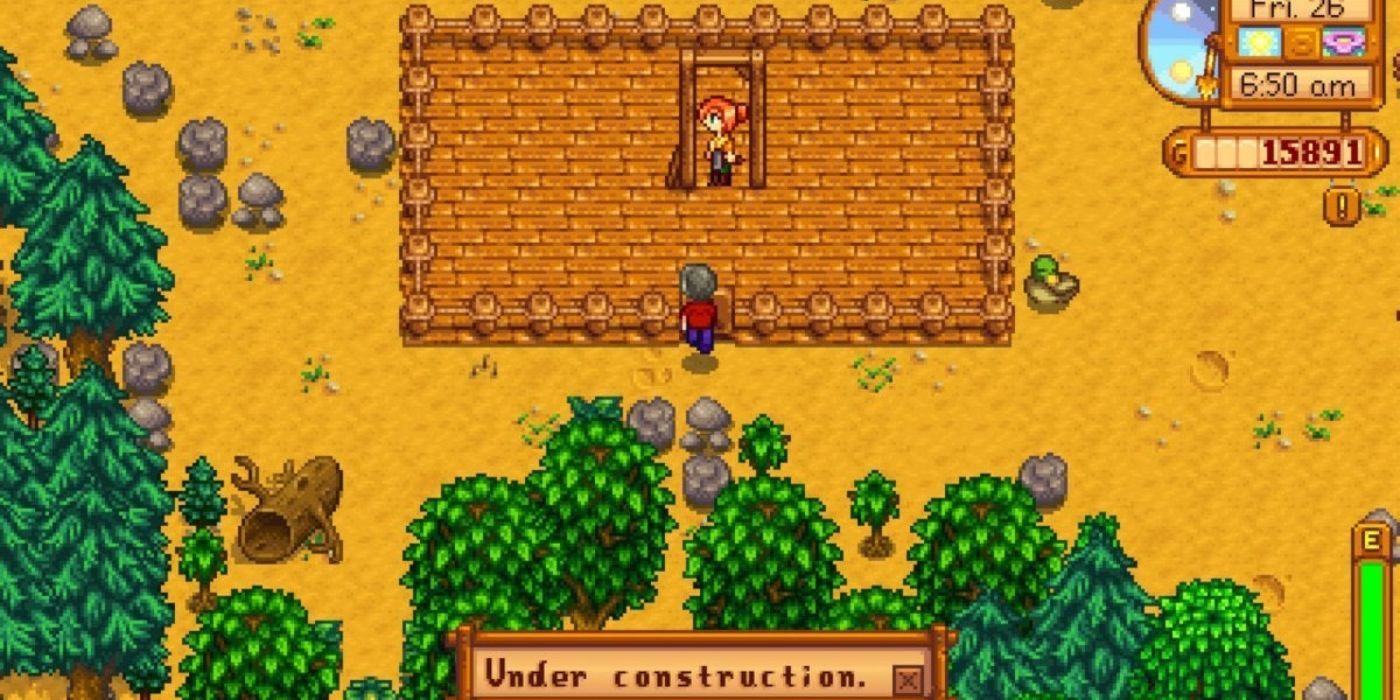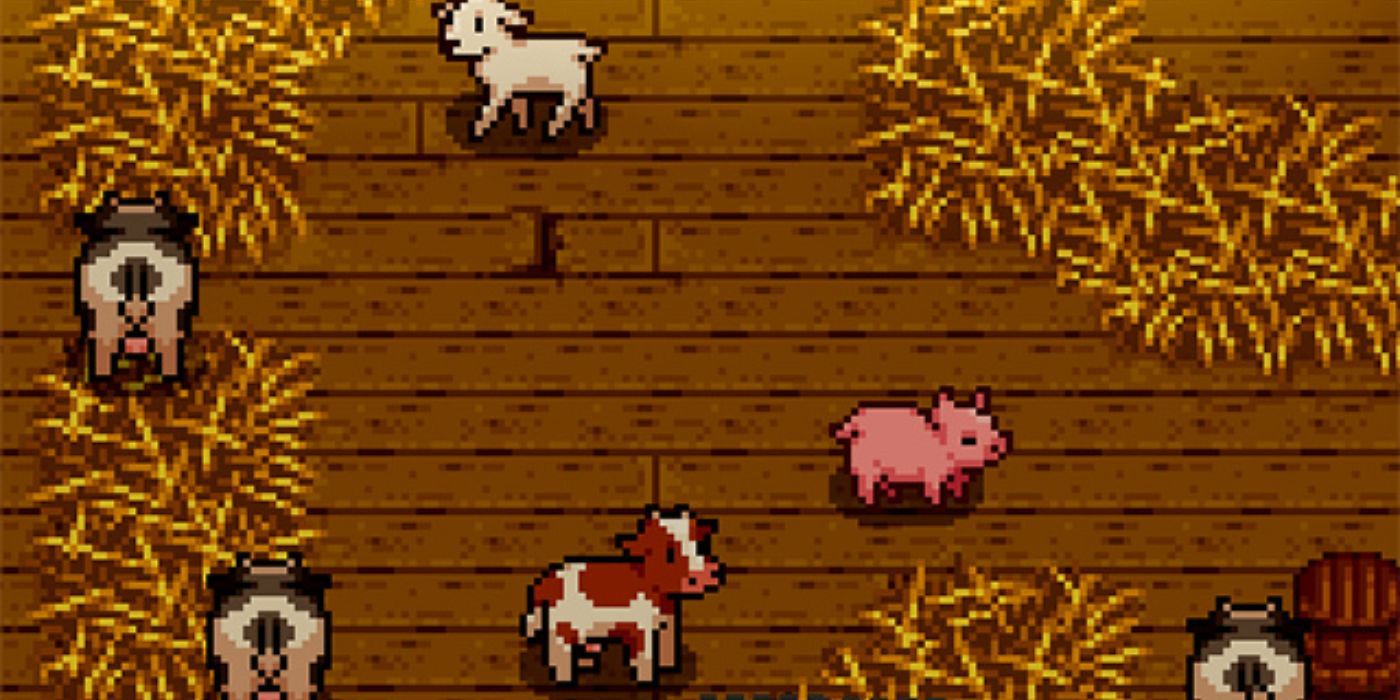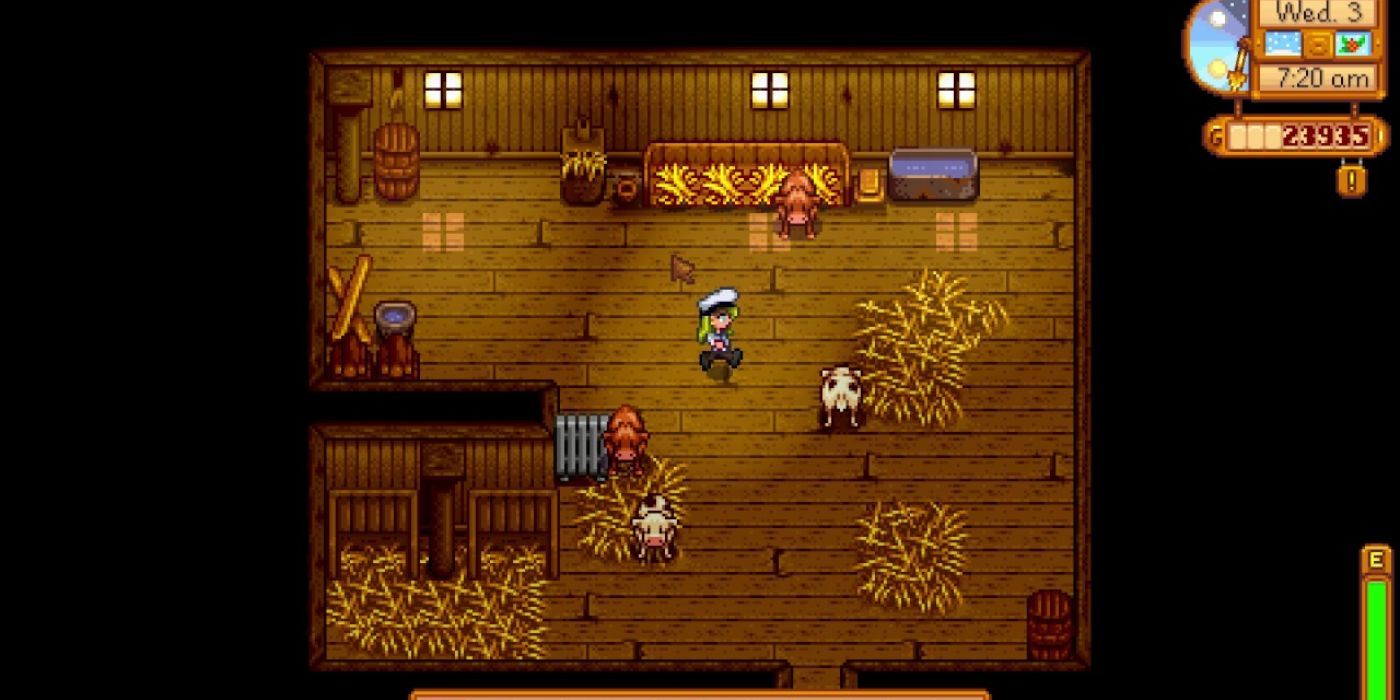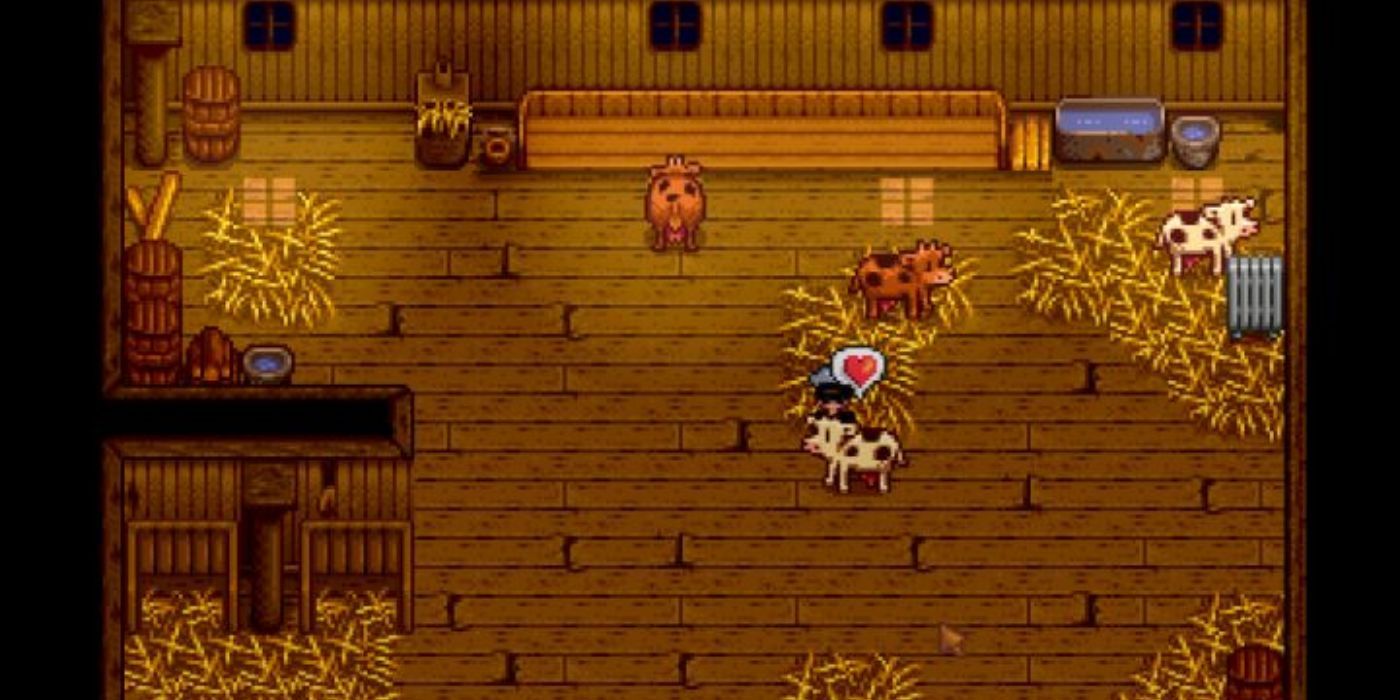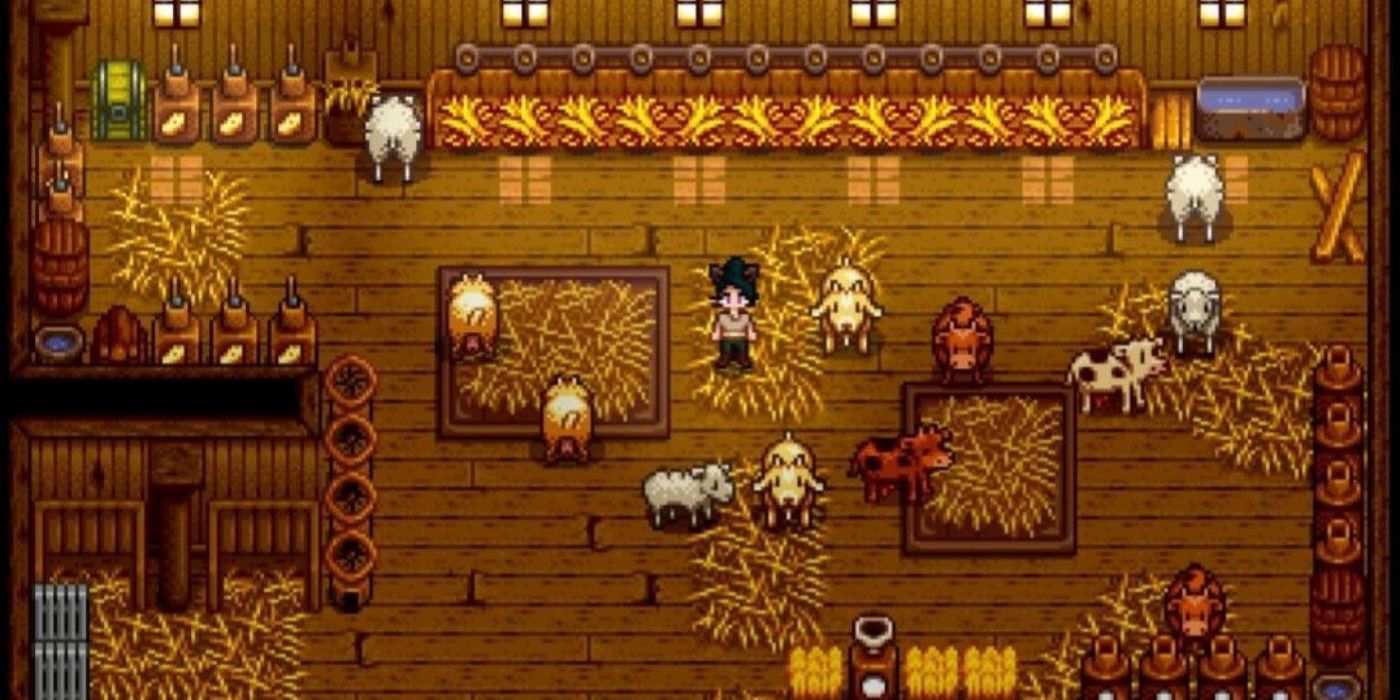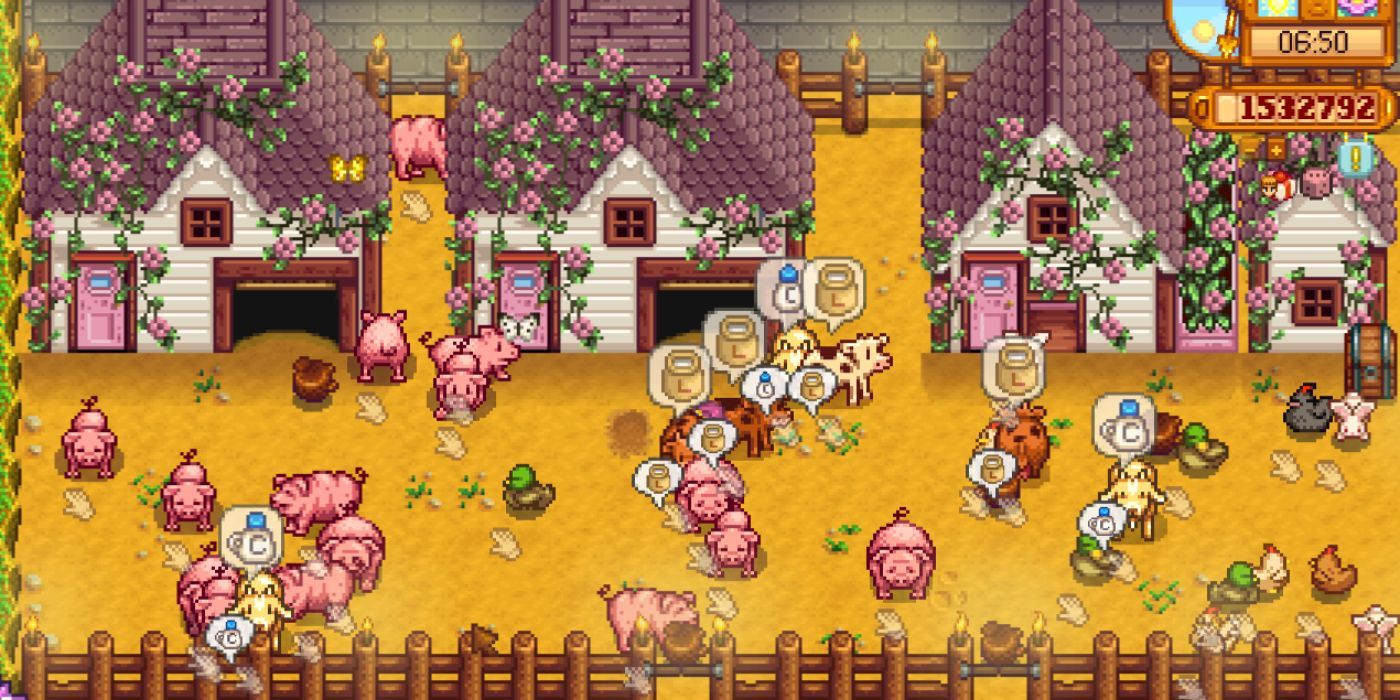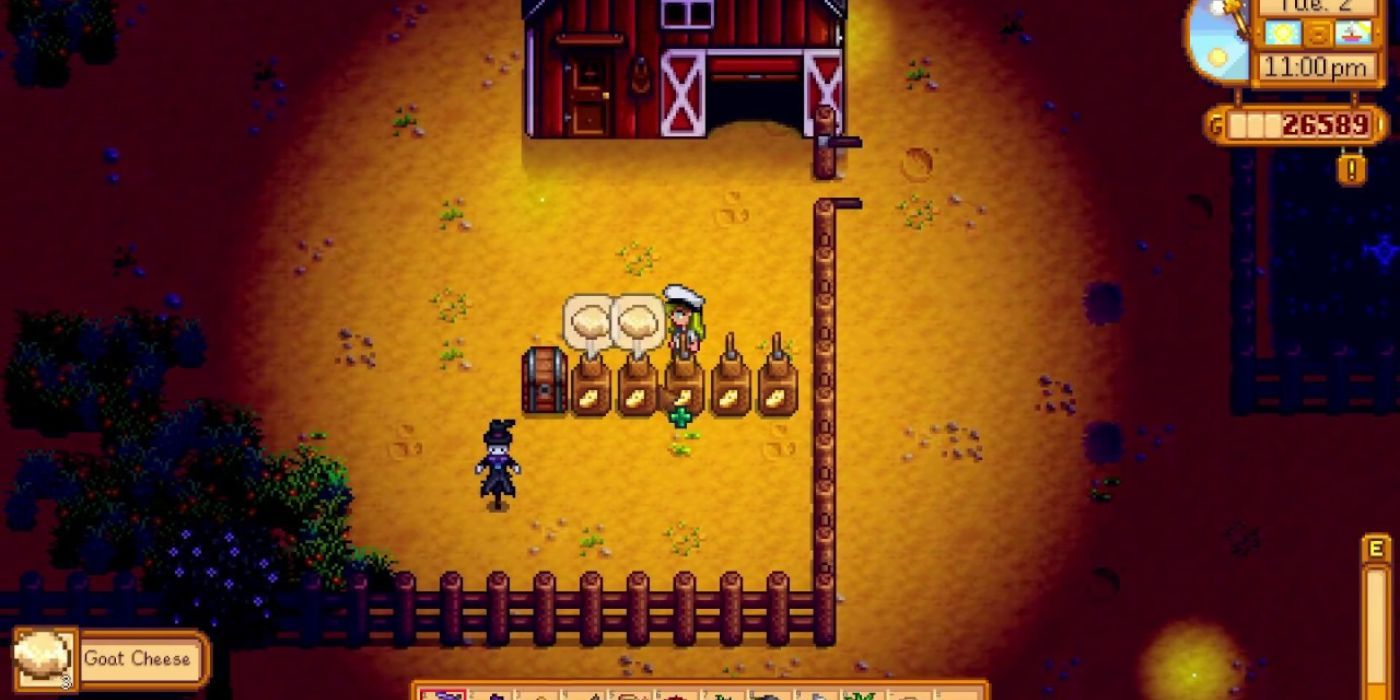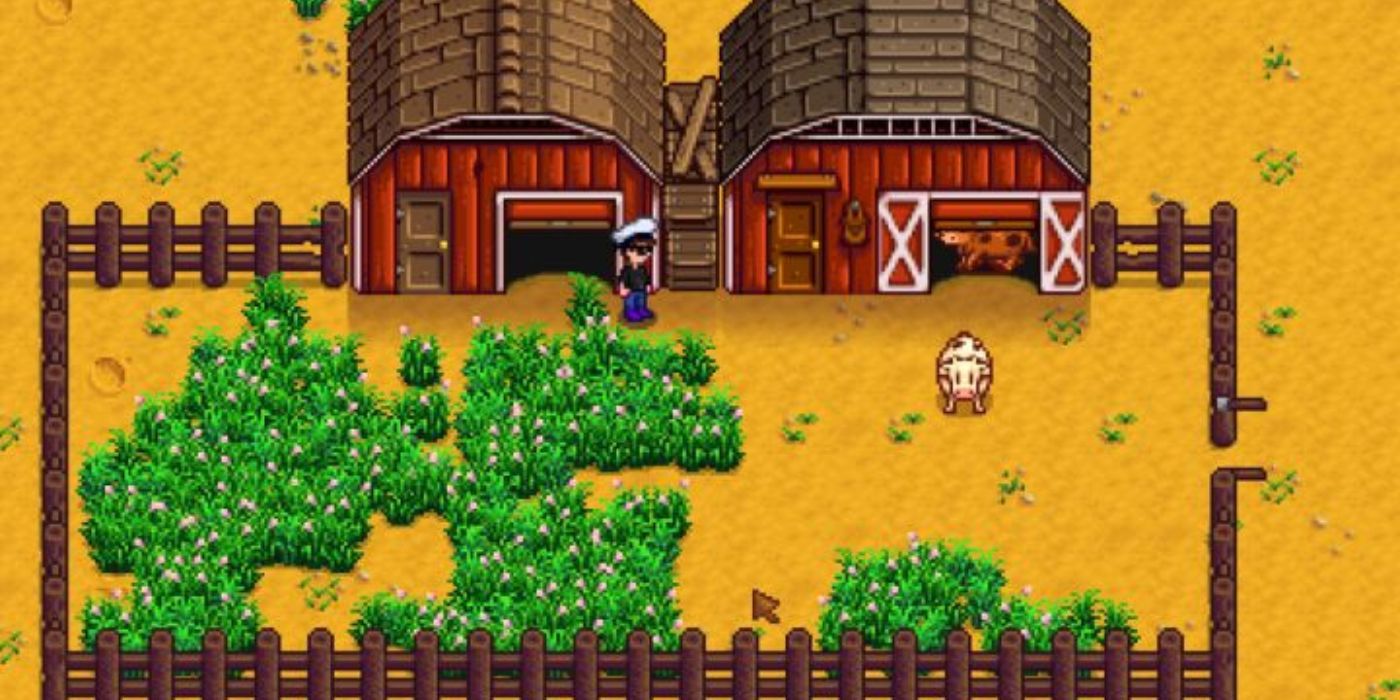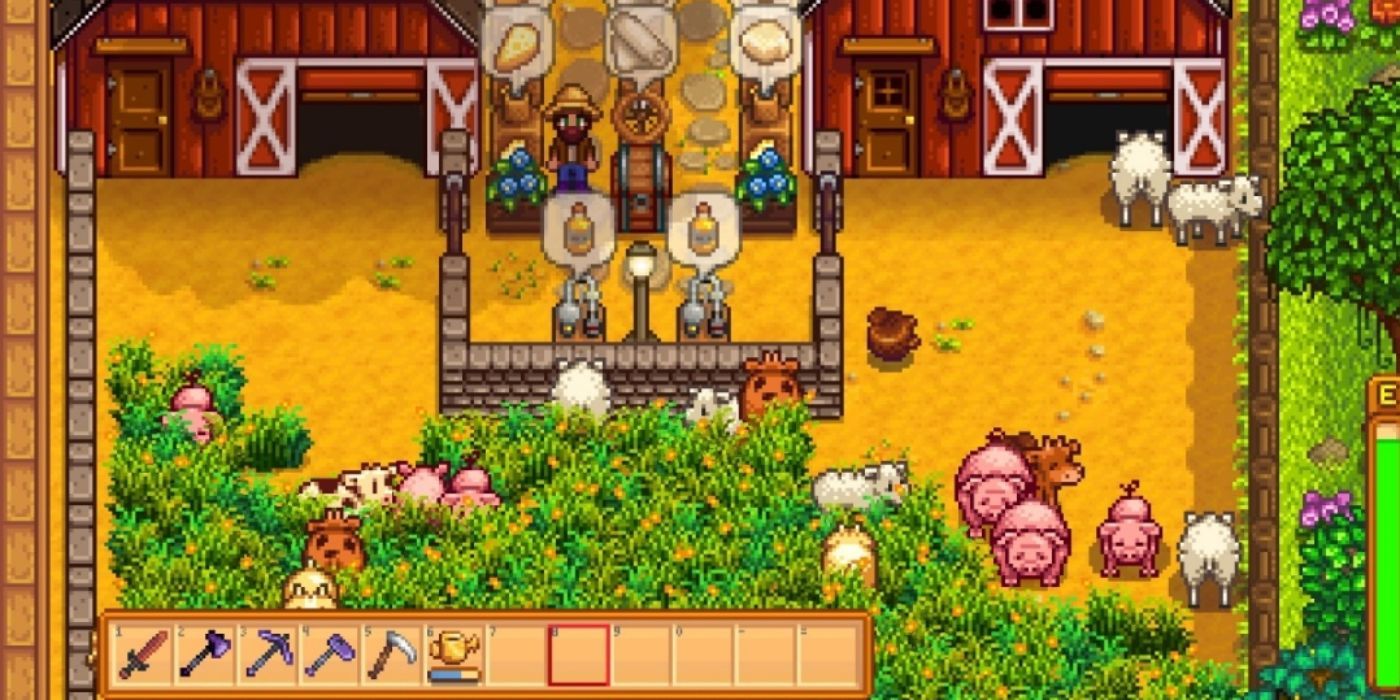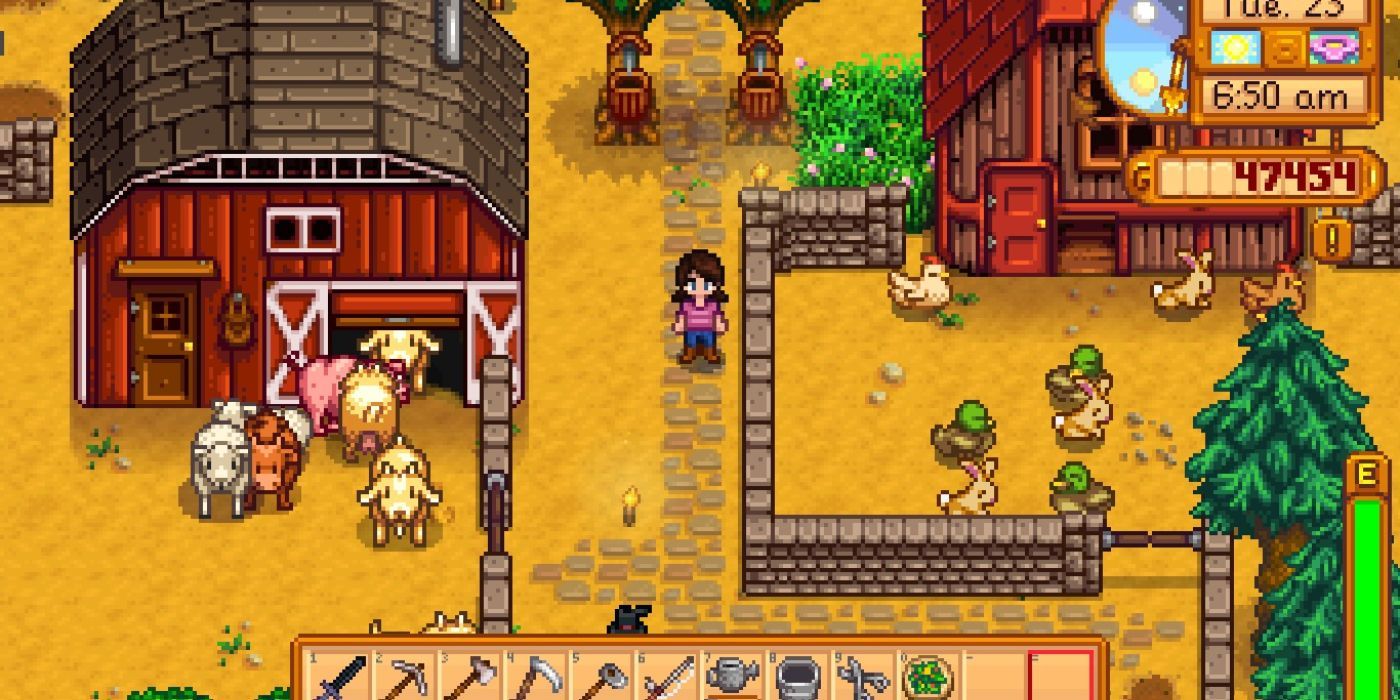In Stardew Valley, the main purpose of the game is whatever the player makes of it. However, bringing grandfather's farm back to its previous glory is probably one of the central plot points of the game, as most of the gameplay is driven around farming, gathering resources, and tending to animals.
The latter is a feature that players should try to unlock as soon as possible. Animals produce valuable resources which can be made into various artisanal goods. These goods can then be sold for a really worthwhile price, and ultimately, earning more money to expand and improve the farm is what every good farmer wants. Here's how to get a barn and some animals, and what to do to get the most out of them.
Updated October 7, 2021 by Erik Petrovich: Getting enough materials and gold for a Stardew Valley barn is only one part of the process of getting a proper ranching operation going on the farm. The first thing to consider, after unlocking the barn, is its placement on the farm. Small things get in the way of placement, and a pasture connecting multiple barns and coops requires a huge amount of space. Plan everything before heading to Robin's to make the purchase, or you'll find yourself wandering back to the farm over and over again to get the placement just right. Luckily enough it's free to move buildings once they've been constructed, but it's annoying to have to run back and forth without a real plan in place.
How To Get A Barn In Stardew Valley
The barn, like most farm structures, must be purchased from Robin's carpenter shop, accessed via the pathway behind the farm or by heading North from Pelican Town. There are no prerequisites for unlocking the initial barn, though it can be a pricey investment. Unlocking the barn isn't just about paying a fee upfront to Robin, though – she'll also ask for all the materials needed for construction.
When first building a barn, the building will take three days to be completed, so make sure to plan ahead and don't expect to get a barn up instantly. Once a barn is up and the player upgrades it, an upgrade will take two days to complete. The first Barn requires 6,000 gold, 350 wood, and 150 stone to build, so it can take a few months to build up the capital. Once built, barns (and coops) are some of the only things that will keep money flowing into the farm through the Winter.
Barn Tiers And Available Animals
Barns come in three different tiers. Each tier is different in size and capacity, and also has some additional features to make the life of barn animals even more pleasant. Moreover, their prices and material requirements are different and increasingly more expensive. Some animals require a specific barn tier to be unlocked in order to move in.
Barn - Tier 1
This is the first type of barn Stardew Valley offers through Robin's shop. It costs 6,000 gold and requires 350 Wood and 150 Stone to build. Four animals can be housed inside, but these animals can only be cows or ostriches. Inside, a hay hopper and feeding bench are included.
Big Barn - Tier 2
The first upgrade from the regular barn costs 12,000 gold and requires 450 Wood and 200 Stone to complete. Animal capacity has been doubled to eight, and players can now have goats as well, on top of ostriches and cows. Animals can also be bred now.
Deluxe Barn - Tier 3
The ultimate barn Stardew Valley has available, this tier costs 25,000 gold and requires 550 Wood and 300 Stone for completion. A total of twelve animals can be housed inside, including two new ones: sheep and pigs. There's now an automatic feeding system in place as well to save the player some time.
How To Unlock Barn Animals
In order to populate the Stardew Valley barn, players need to unlock specific animals from Marnie, who lives south of the player's farm near the forest. Each animal has a different price tag.
- Cow: 1,500 gold.
- Ostrich: hatch an egg by placing it inside the barn. To find one, find the treasure marked in the Journal Scrap #10.
- Goat: 4,000 gold.
- Sheep: 8,000 gold.
- Pig: 16,000 gold.
What Each Animal Produces
Each animal also has something they produce, a basic resource that can be turned into an artisanal product and sold for a good price. All prices listed below are Iridium tier prices, which can be attained when the animal has the highest affinity for the player and has the best possible mood. Bonuses apply if the Rancher or Artisan professions are unlocked, these are simply minimum Iridium tier prices.
- Cows produce milk, which can be turned into cheese. Cheese aged for seven days sells for 460 gold.
- Ostriches lay eggs that can be sold as they are for 1,200 gold. One egg can also yield 10 jars of mayonnaise of the same quality, which can go up to 3,800 gold.
- Goats produce milk, which can also be made into goat cheese. Aged for seven days, it can be sold for 800 gold.
- Sheep produce wool, which is actually better sold as it is if it's at least gold or Iridium tier, rather than turned into cloth. Cloth will always sell at 470 gold, but gold tier wool sells for 510 gold and Iridium at 680 gold.
- Pigs find truffles, which can be turned into truffle oil. If the truffle is Iridium quality, sell it as it is at 1,250 gold for the highest profit. If the truffle is gold or lower, turn it into truffle oil to sell it for a set price of 1,065 gold.
Based on this, pigs are the best barn animal to have. Having a high Foraging profession will ensure every truffle picked up is also the highest possible quality. Artisan profession will also bump up the price of truffle oil, making them insanely valuable. They will pay back their initial buying cost quite fast.
Proper Placement Of A Barn On The Farm
Placing a barn correctly on the farm seems simple at first, but it's incredibly easy to waste time if some things aren't done first – for example, a small rock or a tree branch can put a halt to the project before it even gets started, sending the farmer all the way back just to clear one space. Just like when planning the plots for your crops, it's essential to have an idea for the placement of your barn and pasture well before putting the money (and materials) up for one.
It's typically best to place the barn and pasture close to the house to reduce the amount of time spent walking to gather milk and eggs every day. However, it's also important to keep it close to storage, like sheds, so that ranch materials can be put away for later use without wasting any time. Follow these steps to make sure the space is ready to go when buying a barn from Robin.
- Clear An Area: Use fence posts to mark the placement of your barn, placing them diagonally to the future location of each of the barn's four corners. Each barn, no matter the size, is 7 squares long and 4 squares tall, so be sure to clear out twigs, saplings, rocks, and other debris in the way of this cordoned-off area by measuring these dimensions precisely.
- Consider Coops: It's likely that your farm will have more than one animal, and coops are smaller than barns. Plan to have your coops and other barns next to each other by making the pasture wider than it is tall, giving plenty of room for future developments.
- Plan the Pasture: The pasture can house multiple different animals, meaning a player can use one gigantic pasture rather than individual ones for each coop or barn. The pasture doesn't need to be clear of debris, but there must be nothing in the way of the entrance to the animal abodes.
- Plant Grass: One of the most important things a rancher can do for their animals is to plant grass in the pasture. It grows quickly, can spread over an area, and rapidly increases animal happiness faster than just interacting with them once a day.
Without proper planning, players might find themselves walking all the way back to the farm to destroy a single piece of debris in the way of their planned development. Things one wouldn't expect, like hoed patches of land, also cause issues for Barn placement. Luckily, it's free to move buildings once they've been placed, but that doesn't mean you won't be spending time getting it all just right.
How To Use A Barn
Now that a barn is unlocked and a bunch of animals have been purchased, it's time to start tending to them. Make sure that there's plenty of grass outside of the barn, and gather a bunch inside a silo as well using a scythe in case a rainy day happens. During bad weather or winter, animals won't want to go outside to eat, but during warm seasons, they will get a big mood boost from eating outside.
Make sure to interact with each barn animal on a daily basis by petting them. This will help their mood. Good mood results in better produce and higher rated items. Open up the main barn door to let all the animals out, and at the end of the day make sure all animals are back inside before closing the barn door. Animals left outside will be cranky and might be attacked by wild animals.
During a rainy day, animals must be fed manually. Grass needs to be put on the barn's feeding bench. It can even be left there if the player suspects that bad weather or cold weather will continue for a while. During winter, having a heater inside is a good idea as well. A heater can be purchased from Marnie, and it will boost the mood of any animal.

